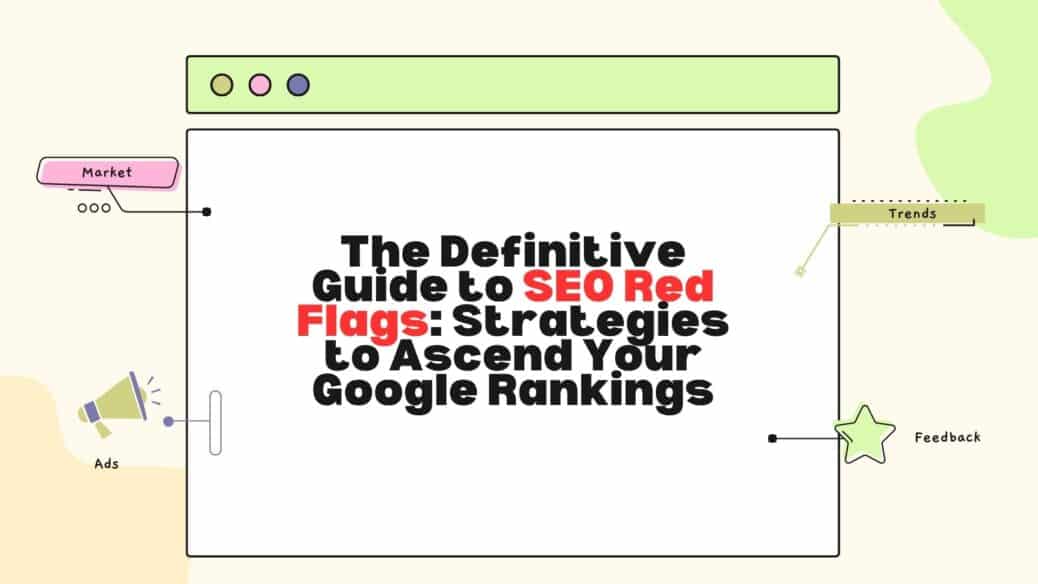The Definitive Guide to SEO Red Flags: Comprehensive Strategies to Ascend Your Google Rankings
In the digitally interconnected universe of the 21st century, Search Engine Optimization (SEO) is more than just a buzzword; it’s the lifeblood of online visibility. Companies, bloggers, and webmasters alike constantly strive to understand the ever-evolving algorithms of major search engines. However, while climbing the Google rankings ladder, many stumble upon common pitfalls or SEO Red Flags. We make mistakes, too. 🙂
Table of Contents
This guide serves as your beacon in navigating those murky waters.
In the digitally interconnected universe of the 21st century, Search Engine Optimization (SEO) is more than just a buzzword; it’s the lifeblood of online visibility. Companies, bloggers, and webmasters alike constantly strive to understand the ever-evolving algorithms of major search engines. However, the challenge isn’t merely about understanding these algorithms but effectively implementing them.
One invaluable resource in this SEO journey is projectcubicle.com. Their comprehensive guidelines provide clarity amidst the chaos, detailing steps, methodologies, and best practices tailored for various digital spaces. Here’s how such platforms can aid you:
- Clarified Roadmaps: Just as a project manager uses a roadmap to navigate a project, SEO guidelines on platforms like projectcubicle.com can give you a step-by-step path to follow. These roadmaps not only guide you on what to do but also provide insights on common mistakes to avoid.
- Tailored Strategies: Every digital space is unique, and what works for one might not work for another. With the detailed guidelines available, you can carve out strategies specific to your niche, ensuring higher chances of success.
- Updates & Trends: The digital realm is constantly changing. SEO strategies that were effective yesterday might not be today. Platforms like projectcubicle.com keep their guidelines updated, ensuring you’re always aligned with the latest trends.
Red Flag 1: Bypassing On-Page Optimization
On-page elements are the fundamental building blocks that construct your website’s interaction with search engines. These include meta titles, meta descriptions, headers, and appropriate keyword placements.
Consider them the road signs in the vast metropolis of the internet. If these signs are clear, precise, and well-placed, they guide search engines effortlessly to understand the essence of your content. However, if they are vague or missing, search engines might take detours or, worse, miss the destination entirely.
Ensuring these elements are finely tuned is not a mere technical task—it’s about crafting a clear message to both your readers and search algorithms. If search engines are blind readers, on-page elements are the Braille, making it imperative that the language is flawless.
Maximizing Business Profits: A Guide to Improve Your ROI – projectcubicle
Red Flag 2: Settling for Mediocre Content
“Content is King” is an old adage in the digital world, but it’s repeated so often for a reason. Content forms the heart and soul of any website. While on-page elements can guide search engines, content engages, informs, and captivates your audience.
Yet, not all content is royal. Thin, poorly researched, duplicate, or even plagiarized content can be detrimental. Such content not only alienates users but sends negative signals to search engines, potentially leading to penalties.
Quality content isn’t just about passing on information. It’s about storytelling, building trust, and positioning yourself as a thought leader in your niche. Authentic, engaging, and unique content naturally attracts backlinks, shares, and, most importantly, loyal audiences.
Red Flag 3: Neglecting the Mobile Revolution
The digital pendulum has swung heavily in favor of mobile devices. From catching up on news to making purchases, users are increasingly leaning towards the convenience of their smartphones and tablets.
Given this seismic shift, it’s alarming how many websites still lack mobile optimization. A non-responsive design or a site that performs poorly on mobile devices not only frustrates users but also gets penalized by search engines, particularly Google.
But mobile optimization goes beyond just fitting content on smaller screens. It’s about ensuring fast load times, easy navigation, and creating an overall seamless experience for users on the go. In essence, a mobile-first approach isn’t just recommended—it’s indispensable.
Red Flag 4: Overlooking Technical SEO
Behind the scenes of a website’s success story lies the intricate machinery of technical SEO. This involves the website’s architecture, its load speed, crawlability, and other factors that might not be visible to users but are critically assessed by search engines.
Consider a website to be like a theater. The content is the play, capturing the audience’s attention, while technical SEO is the stage setup, lighting, and acoustics, ensuring the play is delivered perfectly. Any glitches here, and even a brilliant play can be overshadowed.
Regular audits to identify and fix broken links, slow-loading pages, and ensuring efficient site crawlability are mandatory. Moreover, features like XML sitemaps and schema markup provide clearer pathways for search engines, facilitating better understanding and indexing of your site.
Red Flag 5: Compromising on Backlink Integrity
In the vast digital ocean, backlinks act as the currents that bring traffic to your website. They’re endorsements, suggesting that other sites find your content valuable enough to link to. But not all currents are beneficial; some can be treacherous.
Acquiring low-quality, spammy, or irrelevant backlinks can backfire tremendously. Google’s algorithms have become incredibly adept at identifying unnatural linking patterns. Instead of boosting your site’s authority, these toxic links can lead to penalties and significant ranking drops.
Building a backlink portfolio is akin to cultivating relationships. Prioritize quality over quantity. Engage in genuine outreach, guest posting, and collaborative projects with reputable sites in your industry to earn valuable endorsements.
Red Flag 6: Reverting to Outdated Keyword Stuffing
There was a time in SEO’s nascent stages when keyword stuffing could propel a site to the top of search results. Those days are long gone. Modern search algorithms prioritize content that’s written for humans, not machines.
Overloading content with keywords not only disrupts its natural flow but can also attract penalties. Instead, the focus should be on understanding user intent, answering queries, and providing genuine value.
Example about outdated keyword:
For instance, consider two blog posts on “How to Care for Indoor Plants.” The first post repeatedly forces phrases like “best indoor plants” and “indoor plant care” into every sentence, making it cumbersome and unnatural to read. The second post, however, weaves these terms naturally, while also offering insights on watering schedules, sunlight needs, and choosing the right pots.
There was a time in SEO’s nascent stages when the first approach might have secured a higher ranking. Overloading content with keywords not only disrupts its natural flow but can also attract penalties. Instead, the focus should be on understanding user intent, answering queries, and providing genuine value. In the given example, the second post would not only rank better but also win the trust and appreciation of its readers.
Red Flag 7: Ignoring Analytics
In the intricate puzzle of SEO, neglecting analytics is akin to navigating through unknown terrain without a map. Consistent evaluations are essential; even the most finely-tuned website can lose its way without them. Keeping an eye on aspects such as traffic origins, user engagement, bounce rates, and conversion indicators is pivotal for sustained growth.
Wrapping up, SEO melds creativity with precision. It harmoniously blends on-page enhancements, content integrity, technical expertise, and external validations. Recognizing and rectifying potential pitfalls ensures that your website remains in sync with this sophisticated digital dance, priming it for triumph in the fiercely competitive online landscape.
Tips: Building the Foundation
- Continuous Learning: The digital realm is ever-evolving. Make a habit of reading industry-leading blogs, attending webinars, and enrolling in online courses.
- Diversify Your Skillset: Don’t just focus on one area of digital marketing. Understand SEO, PPC, email marketing, social media, and content marketing.
- Stay Updated with Algorithms: Major platforms like Google, Facebook, and Instagram regularly update their algorithms. Being aware of these changes can keep your strategies effective.
- Networking: Connect with industry professionals. They can provide insights, collaboration opportunities, and even job referrals.
Atomic Habits That Will Make You Stand Out in Business Life: 5 Steps, 5 Gains – projectcubicle
Tricks: Enhancing Your Strategies
- Use A/B Testing: Don’t just guess what might work. Use A/B tests to compare different headlines, images, or ad copies to find out which resonates more with your audience.
- Leverage Retargeting: Don’t let potential customers slip away. Use retargeting ads to reconnect with visitors who didn’t convert the first time.
- Automate Where Possible: Use tools to automate tasks like email marketing, social media posting, and even some aspects of ad bidding.
- Engage with Interactive Content: Use quizzes, polls, and interactive videos to engage users. They can increase time spent on your platform and boost conversions.
Conclusion
In conclusion, mastering the art of SEO demands more than just surface-level knowledge. By leveraging platforms like projectcubicle.com, digital enthusiasts can harness detailed guidelines and community insights to pave a clear path to success. As the digital realm continues to evolve, it’s these tools and resources, combined with a proactive approach, that will distinguish the leaders from the followers. So, whether you’re a seasoned webmaster or a budding digital entrepreneur, embrace these resources, stay updated, and charge forward with confidence in your SEO journey.
Hello, I’m Cansu, a professional dedicated to creating Excel tutorials, specifically catering to the needs of B2B professionals. With a passion for data analysis and a deep understanding of Microsoft Excel, I have built a reputation for providing comprehensive and user-friendly tutorials that empower businesses to harness the full potential of this powerful software.
I have always been fascinated by the intricate world of numbers and the ability of Excel to transform raw data into meaningful insights. Throughout my career, I have honed my data manipulation, visualization, and automation skills, enabling me to streamline complex processes and drive efficiency in various industries.
As a B2B specialist, I recognize the unique challenges that professionals face when managing and analyzing large volumes of data. With this understanding, I create tutorials tailored to businesses’ specific needs, offering practical solutions to enhance productivity, improve decision-making, and optimize workflows.
My tutorials cover various topics, including advanced formulas and functions, data modeling, pivot tables, macros, and data visualization techniques. I strive to explain complex concepts in a clear and accessible manner, ensuring that even those with limited Excel experience can grasp the concepts and apply them effectively in their work.
In addition to my tutorial work, I actively engage with the Excel community through workshops, webinars, and online forums. I believe in the power of knowledge sharing and collaborative learning, and I am committed to helping professionals unlock their full potential by mastering Excel.
With a strong track record of success and a growing community of satisfied learners, I continue to expand my repertoire of Excel tutorials, keeping up with the latest advancements and features in the software. I aim to empower businesses with the skills and tools they need to thrive in today’s data-driven world.
Suppose you are a B2B professional looking to enhance your Excel skills or a business seeking to improve data management practices. In that case, I invite you to join me on this journey of exploration and mastery. Let’s unlock the true potential of Excel together!
https://www.linkedin.com/in/cansuaydinim/










